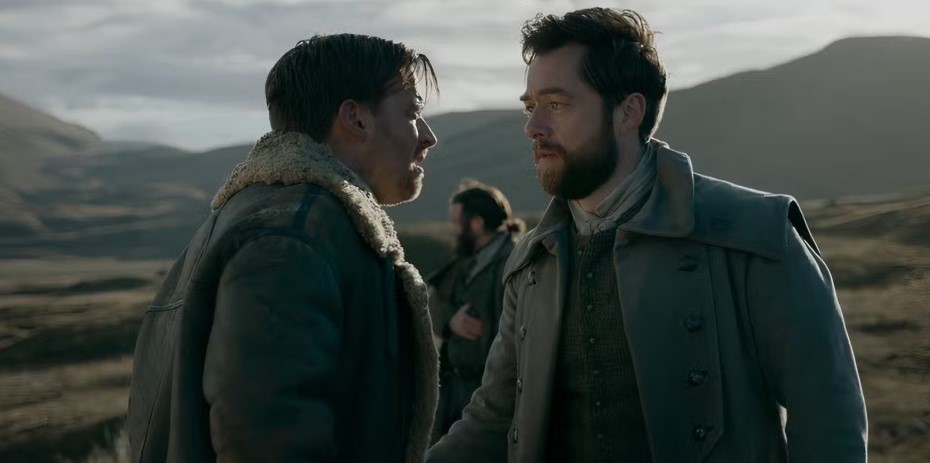Time travel is always complicated, but Outlander season 7, episode 13 made things even more confusing. The fantasy series has seen characters make multiple attempts to go back in time and change events of the past, but it never quite works out that way.
Outlander uses a time travel model that is more paradoxical, so anything that a time traveler does in the past only ensures events of the future rather than change them. Despite this, Roger gave his best effort to save his father in Outlander season 7, but the vision he receives in episode 13 makes the whole thing a bit more confusing.
Roger’s father, Jerry MacKenzie, disappeared and was presumed dead when his plane crashed during World War II. However, Roger’s adventures in 1739 in Outlander season 7 reveal that there is more to the story. Roger and Buck discovered Jerry’s dog tags in the 18th century and quickly deduced that, rather than dying in the war, Jerry MacKenzie had accidentally traveled back in time. Roger successfully found his father in 1739 and helped him get back through the stones to his own time. This is when Roger saw a vision of his five-year-old self snuggled up close with Jerry.
Roger’s Vison With His Father Is Misleading In Outlander Season 7

Outlander Makes It Look As If Roger Created A New Memory
Roger mentioned in Outlander season 7, episode 13, that he thought he might be flooded with memories of growing up with his father once Jerry was sent back to his own time. He still seems to hope that changing things in the past will somehow change history. Instead, Roger only received his rather confusing vision. Jerry disappeared when his son was only a baby, so the vision of a five-year-old Roger snuggled up to his father in Outlander implies that these characters had successfully changed the past. How else would Roger only possess this memory the moment Jerry went through the stones?
In truth, Roger changed nothing by saving his father in 1739 and sending him back through the stones. In the Outlander books, Roger never discovers what happened to Jerry after he says his final “I love you” to his father as the man disappeared. Since he wasn’t raised by the man, Roger assumed that Jerry didn’t make it through the stones. However, author Diana Gabaldon’s novella A Leaf on the Wind of All Hallows reveals that Jerry traveled to point a few years after he initially disappeared and found his wife and son just in time to save Roger during the Blitz before dying himself.
No one actually changed the past, but the vision Roger received in Outlander season 7 implies otherwise, especially since the TV show has left Jerry’s true fate ambiguous.
Jerry saved Roger when the latter was only five, but no one ever knew this since Jerry wasn’t wearing his dog tags—he was buried as a John Doe. This only happened because Roger went back in time, but it was already a part of his history. No one actually changed the past, but the vision Roger received in Outlander season 7 implies otherwise, especially since the TV show has left Jerry’s true fate ambiguous.
Outlander Uses A Paradoxical Time-Travel Model

The Past Can’t Actually Be Changed In Outlander
There are a couple of different time-travel models that movies and TV shows typically use. One is a “changeable timeline” model, which allows characters to travel back in time and change events of their own future (think Marty McFly almost erasing his own existence in Back to the Future). On the other hand, the paradoxical time-travel model makes it impossible to change anything.
Anything someone does in the past will only ensure the future. For example, Brianna went back in time in Outlander to save her parents from the house fire but ended up being the one who caused the inferno.
Outlander consistently uses a paradoxical time-travel model, and Roger’s journey to save his father in the 18th century so that his father could save his life in the 20th is another example of this. However, the characters of Outlander continue to make efforts to change history despite the consistent evidence that this isn’t possible. Roger receiving a vision of himself with Jerry only contributes to this confusion. It makes it seem as if Roger successfully changed the past and somehow received a vision of an alternate reality of sorts. Outlander must provide a definitive explanation of Jerry’s fate to clear things up.
Outlander Must Reveal What Really Happened To Jerry MacKenzie

The Outlander TV Show Must Do What The Central Book Series Didn’t
Diana Gabaldon’s spinoff novella A Leaf on the Wind of All Hallows reveals the full picture of Jerry’s story and makes it clear what Roger’s efforts in 1739 really achieved. However, it looks as if the Outlander TV show will only give audiences a glimpse of Roger and Jerry’s moment together in the London underground. Rather than clarifying the clever paradox that Roger’s time-traveling achieved, this vision only makes it appear as if it is actually possible to change the past. This makes Outlander’s big twists and turns far less interesting and makes the intricacies of time travel all the murkier.
Hopefully, Outlander will reveal that Roger’s vision wasn’t a vision at all but a memory he only recalled because of his reunion with Jerry MacKenzie. This would mean that, in the TV show’s version of events, Roger must learn the truth about Jerry—something that hasn’t happened in the books. There are benefits to stories like Jerry’s being left ambiguous, but in the case of Outlander, more definitive answers are a must to ensure that audiences understanding of how time travel works in this fictional universe remains accurate.
